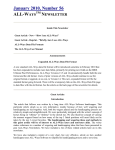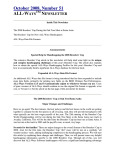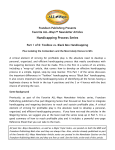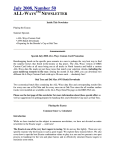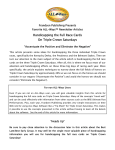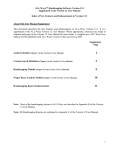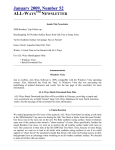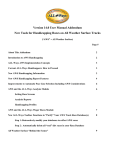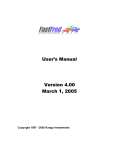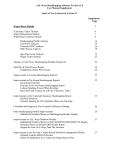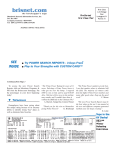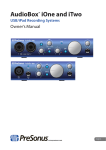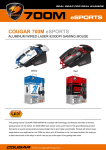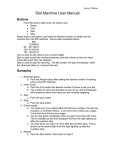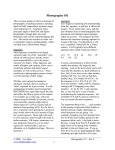Download April 2007 Number 45
Transcript
April 2007, Number 45 ALL-WAYSTM NEWSLETTER Inside This Newsletter ALL-Ways Multi-Level Software • Level ONE Recap • Level TWO: Unleashing ALL-Ways Databases • Frequently Asked Questions • Reminders Handicapping Process Series • Part 4: Getting “Un-stuck” Version 14 Update Announcements Effective immediately, the new e-mail address for Frandsen Publishing is [email protected]. This is a different new address than previously announced because our local corporate cable service provided by Time Warner has been taken over by Comcast. National Handicapper of the Year! Congratulations to ALL-Ways software and Ultimate PP user Stanley Bavlish on his win at the 8th Annual NTRA National Handicapping Championship in Las Vegas. ALL-Ways Multi-Level Professional Edition Software “From novice to expert at a reasonable pace” In January 2007, Frandsen Publishing and BRIS made three important announcements: 1) We announced that ALL-Ways Professional Edition software is now available free of charge to all BRIS customers. The software includes all Professional Edition features that were previously excluded from the Standard Edition. 2) We announced the release of the new ALL-Ways Multi-Level Professional Edition software. The new software is based on a four-level architecture ranging from Level ONE for new users and gradually moving up to the most sophisticated tools in Level FOUR for experienced users. 3) We announced a special effort in 2007 to help new ALL-Ways software users go “From novice to expert at a reasonable pace”. The January newsletter included a comprehensive description of the Multi-Level features and introduced Level ONE. This April 2007 newsletter introduces you to Level TWO. Level THREE and Level FOUR will be covered in our July 2007 and October 2007 newsletters respectively. Level ONE Recap Level ONE is named “Getting Started with the Basics”. The primary focus of Level ONE is: • Download and automatically process ALL-Ways race card data files. • Use the ALL-Ways Handicapping Module to automatically handicap the races and to display and/or print selected Level ONE handicapping reports. • After the races are run, download and automatically process results data files. • Learn the Level ONE handicapping reports and handicapping factors. There are two new concepts to learn in order to get the most out of Level ONE. One is to develop an understanding of the basic fundamentals of “How ALL-Ways Works”. Second is the concept of “Race Pace Shapes”, a very powerful way to evaluate the pace match-up scenarios in a race. When you install ALL-Ways software on your computer, two short, easy-to-read papers are included in the ALL-Ways Windows Program Group covering these topics. If you have not already read our January 2007 Newsletter (#44), we suggest doing so before moving up to Level TWO. Level TWO “Unleashing ALL-Ways Databases” ALL-Ways Race Databases When ALL-Ways software automatically processes an ALL-Ways data file for a race card, the races are added to your ALL-Ways Race Database for the track. After the races are run, ALLWays software automatically processes the race results file to add the results to the Race Database. When your Race Database for a track reaches 200 to 300 or so races (20 to 30 race cards), you are ready to move up to Level TWO and start using the powerful features in the ALL-Ways Analysis Module. ALL-Ways Handicapping Profiles The primary new concept to learn in Level TWO is how to automatically create, update and evaluate ALL-Ways Handicapping Profiles and how to use the profiles at handicapping time. “In a nutshell”, ALL-Ways software uses your Race Database for a track to automatically create Handicapping Profiles that are both race track specific and race type specific. These profiles look not only for win horses in each race, but for place, show and 4th place horses as well. Each Handicapping Profile is made up of six to seven of ALL-Ways 87 key handicapping factors that work best in combination with each other. And the handicapping factors are weighted by their Impact Values. ALL-Ways software gives you the flexibility to decide which Handicapping Profile(s) you want ALL-Ways software to use when handicapping each specific race. The Multi-Level instructions in Chapter 2 of the ALL-Ways User Manual provide brief, clear, concise information to help you make your profile selections. ALL-Ways software uses the profiles you select at handicapping time to evaluate each horse within the context of the race showing you the ALL-Ways win probability for each horse (compared to the Morning Line). ALL-Ways software also shows you the horses ALL-Ways software considers to be the prime contenders, horses ALL-Ways software designates as ‘Dangerous Non-Contenders’ and ALL-Ways software designation of horses considered to be good Key-Horse Candidates. There are four fundamental types of Handicapping Profiles in Level TWO: 1) The MRA Default profiles specialize in identifying all the horses with a legitimate chance of finishing in the top 4; 2) The MRA Pace profiles focus on evaluating how each horse will likely perform based on the pace match-ups in the race; 3) The Race Card Best Factor profiles specialize only on finding the winning horse; 4) The Race Card MRA profiles also look for the top 4 finishers. Note that the Race Card profiles include an individual profile targeted at each individual race on the race card. (Note: MRA = Multiple Regression Analysis.) Major New Features in Level TWO The major new features in Level TWO include the Race Card function, the Analysis Module Automatic function, the three profile consensus handicapping capability, additional handicapping reports and the Custom Report feature. Race Card Functions When, with a simple mouse click, you instruct ALL-Ways software to run the Race Card function in the Analysis Module, ALL-Ways software automatically goes through every race on the race card, one race at a time. For each individual race, ALL-Ways software finds all similar races in your Race Database for the track. ALL-Ways software then automatically runs an Impact Value analysis to find the very best handicapping factors and automatically creates a Race Card Best Factor profile that specializes in looking for winning horses for the specific race type. ALL-Ways software then automatically creates a Race Card MRA profile that looks for win, place, show and 4th place horses for the specific race type. After all races on the card have been completed, ALL-Ways software prints out a one page Race Card Summary Report showing you critical information about every race on the card, much of which is not available from any other source in the industry, giving you unique and very powerful insights into the races. Analysis Module Automatic Functions The Automatic Function is a great time saver. By simply clicking a button, you can instruct ALL-Ways software to automatically perform all the following tasks: • Update MRA Default profiles • Update MRA Pace profiles • Create Race Card Best Factor profiles • Create Race Card MRA profiles • Print the one-page Race Card Summary • Calculate profile performance statistics • Update Gap statistics • Update Key Horse statistics So, you can get 100% ready to handicap a full race card in just a couple minutes with a simple mouse click. And, if you are playing multiple tracks, you can actually do all of this for up to 4 different tracks at the same time. Three Profile Handicapping Level TWO lets you use up to three different profiles at the same time to handicap a race. ALLWays software automatically handicaps the race three times and shows you the results for each profile. This is a very powerful consensus handicapping capability. Additional Handicapping Reports • Odds-Line Report • ALL-Factors Report: Horse Rankings • ALL-Factors Report: Gap Values • Track Bias/Jockey Trainer Report • Full Pedigree Report • Form-by-the-Numbers Report • Form Graphs • Brohamer Plus Report • All Pace Report • Pace Past Performance Report • Spot Play-Final Process Report • Custom Reports Three of these reports (shown in bold above) deserve special mention: The Form-by-the-Numbers Report, new in ALL-Ways Version 13, provides unbelievable incite into how a horse might perform today based on the horses form and based on situational factors compared to the horse’s past performances. Much of this information is not available from any other source in the industry. This gives you a major advantage over the public. The Spot Play-Final Process Report has been designed as a very powerful standalone report that leads you through a decision process. It begins with the ALL-Ways software handicapping designations and then, as you move down the page, goes through human factors (trainer and jockey statistics), suitability to distance and surface, current form, class level, speed, pace, a number of important situational factors and, finally, the very powerful Hall figures that are particularly strong for evaluating horses changing distance and/or surface. The Custom Reports feature lets you design your own handicapping reports with just the information you want to see. You can actually design up to 28 different Custom reports. This powerful feature is a great way to implement your personal handicapping process. It is also a great way to create handicapping reports for special situations such as for muddy tracks, maiden races with first time starters, turf races, etc., etc. In Level TWO, all ALL-Ways software handicapping reports are available to you. They are simply more tools in the big ALL-Ways software handicapping toolbox. It is a good idea to review these handicapping reports and decide which reports you want to use in your personal handicapping process. Most ALL-Ways software users settle on 3 to 5 reports that best suit their interests and style of play. Frequently Asked Questions Here are a few questions we have heard over the past couple months from people giving ALLWays software a try for the first time. FAQ: What Handicapping Profiles should I use? We suggest looking at the Level One and Level Two instructions in Chapter 2 of the ALL-Ways User Manual for more information on this question. Our favorite approach is to use the MRA Pace profile in Profile Position #1 (finds higher priced horses), the Race Card MRA profile in position #2 (the most consistently powerful profile in ALL-Ways software) and the MRA Default profile in position #3 (picks up any “stragglers” for the top 4 finish positions). Another simple, but very effective, approach is to use the non-pace biased MRA Default profile in position #1, the early biased MRA Default profile in position #2 and the late biased MRA Default profile in position #3. This approach does a great job of identifying the best overall horses and points out the very best early running (“E” and “EP”) horses and the very best late running (“P” and “S”) horses. And remember, each individual profile generates a win probability for every horse. FAQ: Should I pay more attention to the Pace-Line speed and pace handicapping factors or to the Best 2/3 speed and pace factors? A good way to approach this is to first determine if the pace line race is a “True” race, meaning the race was the same distance category (sprint or route) and the same surface (dirt or turf) as today’s race. When ALL-Ways software shows you the Pace-Line figures, it will show you a “T” indicating the pace line is “True” or an “N” if it is not true. So, the pace line figures represent a single race. The Best 2/3 figures give you the average figure for the horse’s best two of its last three races. If the pace line is “True”, most users will use the pace line figures. But, here is a key point: Always look to see if there is a meaningful difference between a horse’s pace line figures and the horse’s Best 2/3 figures. When you see such a difference, look at the past performance lines to see why there is a difference. This frequently leads to some interesting revelations about the horse, sometimes positive and sometimes negative. The key is to see why there are differences. FAQ: Should I pay more attention to the BRIS Speed and pace figures or to the Hall speed and pace figures? First, it is important to know about the different ways these figures are derived. The BRIS pace and speed figures take a horse’s times and adjust for the daily track variant and, if today’s track is different than the past performance track, also makes a track-to-track adjustment. The Hall figures are determined the same way, but go an extra step. The Hall figures are also adjusted (normalized) to the surface and exact distance of today’s race using an approach we call “Conservation of Energy”. The BRIS figures will frequently have somewhat higher Impact Values. The Hall figures will, on the other hand, frequently find higher priced horses. The Hall figures are particularly strong when evaluating horses that are changing surface or distance in today’s race. The Hall figures are also the basis for many successful long shot horses that ALL-Ways software designates as “Dangerous Non-Contenders”. FAQ: How do I print the free BRIS Ultimate Past Performances? The same ALL-Ways data file you download to drive your ALL-Ways software can be used, at no additional cost, to drive the BRIS Past Performance Generator software to print the BRIS Ultimate Past Performances. So, you do need to download and install the BRIS PP Generator software from the Free Software page on the BRIS Web site. It is very fast and very easy to do. When you start up and use the PP Generator software, all you need to do is load the ALL-Ways data file that is in your Frandata folder. You can also set up the PP Generator system so the Frandata folder is the default folder. Reminders The ALL-Ways User Manual There is no need to read the entire User Manual. It has been designed as a comprehensive reference tool where you will find answers to just about any question you have. New ALL-Ways software users are encouraged to read Chapter 1 of the User Manual for an introduction to ALLWays software. Then, utilize Chapter 2, which includes a set of easy-to-follow, step-by-step directions for each individual level. When needed, these individual level instructions reference other chapters in the User Manual for more detailed information. There are three ways to obtain the User Manual: 1) You can open the manual on-line on the ALL-Ways Free Software page on the BRIS Web site; 2) or, you can download the manual from the same location and open the manual in your computer. The manual is a PDF file; 3) or, you can telephone BRIS at 800-3549206 and BRIS will mail the printed manual to you in a 3-ring binder along with an ALL-Ways software CD. There is a modest S&H charge for this option. ALL-Ways Newsletters All ALL-Ways Newsletters are posted on the Frandsen Publishing Web site at www.frandsen.com. You can print the newsletter(s) you want to review absolutely free of charge. A Master Topic Index can also be displayed or printed to help you locate the topics of interest. We strongly recommend reading the five part Wagering Series which has received rave reviews in the industry. And, the current Handicapping Process Series is must reading for new ALL-Ways software handicappers. Part 4 of the Handicapping Process Series is presented below. Handicapping Process Series Part 4 “Getting Un-Stuck” The purpose of this overall series is to help you develop a personal, organized, and efficient handicapping process that leads to effective handicapping and wagering decisions. The series logically follows up on our previous five part Wagering Series. If you have not read the articles in our Wagering Series, we suggest you at the least read the series wrap up in our April 2006 Newsletter. In Part 1 (“Toolbox Handicapping”) of this Handicapping Process Series, we covered how to identify the horses that may have a decent shot of finishing in the top four (“the players”) and how to isolate the 3 or 4 horses with the best chance to win the race. In Part 2 (“The Keystone”), we described how to place “the players” in one of 3 groups. Group 1 includes the horses having a good chance to win the race, Group 2 includes other horses with a good chance to finish in-themoney and Group 3 includes marginal horses that, nevertheless, should not be ignored. Part 2 also showed how to classify the favorite as “legitimate”, “vulnerable” or “false”. Part 3 (“Key Decisions”) of the series discussed how to identify the two non-favorite horses with the best chance to beat the favorite and how to identify a good Key Horse. We have decided to expand this Handicapping Process Series to six parts. Part 4 (“Getting Unstuck”) in this April 2007 Newsletter presents some ideas that may help you better organize your thoughts as you work to develop your own, personal handicapping process. Part 5 (“Feedback”), coming up in our July 2007 Newsletter, will discuss powerful tools in ALL-Ways software to help you analyze what is and what is not working in your handicapping process and it will “come full circle” by tying your new handicapping process back to the handicapping and wagering concepts in the Wagering Series. Finally, Part 6 (“Handicapping Automation”), coming up in our October 2007 Newsletter will tie into ALL-Ways Multi-Level FOUR with very powerful ways to have ALL-Ways software do a great deal of the work for you to carry out your own personal handicapping process. Getting “Un-Stuck” Developing an efficient and effective personal handicapping process is not an easy thing to do, but it is absolutely essential for profitable play. It is easy to make the process development effort harder than it needs to be. And, the process should keep being refined over time. In this Part 4, we are going to provide some ideas that may help you make good progress with less hassle. Some reminders: 1) Toolbox Handicapping: Remember that ALL-Ways software is a very large toolbox of powerful handicapping tools. You will never use them all. Instead, you should select and integrate the ALL-Ways software tools that best suit your personal handicapping process. 2) Unique Information: Just about every handicapper has easy access to speed and class information as well as past performances. You must use this fundamental information as well. But, to handicap and wager better than other players, you should take advantage of as much unique information as possible that is not generally in the hands of the public. It is this unique information that gives you the edge over your competitors, namely the other horseplayers. ALLWays software abounds with unique handicapping information. 3) Comprehensive Handicapping: Successful handicapping means you must go far beyond the basics of speed and class. You will want to cover suitability to the distance and surface of today’s race, class, current form, pace, speed, jockey/trainer considerations and, in some cases, pedigree information. You will also want to include important situational considerations that provide insight into whether the horse can be expected to do as well as its past performances or if it may do better or worse. Some Helpful Ideas Here are some ideas that may help you make good progress in developing your personal handicapping process. Ask Questions: This may seem obvious, but many people will find this technique to be very helpful. Ask yourself key questions in order to determine the information you need and then find the best source of the information. To get your thought processes going, here are examples of the kinds of questions you may want to ask: “What would convince me …….” • the horse is a legitimate contender? • the horse is an ALL-Ways Dangerous Non-Contender that I should pay special attention to? • the horse deserves to be in Group 1 (win candidates)? • the horse deserves to be In Group 2 (in-the-money)? • the horse deserves to be In Group 3 (marginal horses)? • the horse is a legitimate favorite? • the horse is a vulnerable favorite? • the horse is a false favorite? • the horse would be a good Key Horse • the horse will do better than its last race? • the horse will do worse today than its last race? • etc., etc., etc. Ask Both “Why?” and “Why Not?”: For example, ask “What would convince me the horse should be in Group 1?” And, ask “What would convince me the horse does not belong in Group 1? Your thought process for the “Why?” answers and for the “Why not?” answers will be very different. It is good to see positive things about a horse. But, it is equally important to find the negative things as well. Avoid Self Fulfilling Prophecies: A very common problem in a handicapping process is to see a horse that you like early in the process and then make your initial evaluation come true by accentuating positive things and downplaying the importance of negative things. Keep It Simple: Don’t try to do too much too quickly. Let the process evolve. Most people will not be able to go from a lack of success to all success in a short period of time. There are a couple of specific things we recommend regarding this. One is to read our Wagering Series, paying particular attention to the concept of mastering the foundation wagers before moving up the logical progression to the more advanced wagers. This will greatly simplify your initial handicapping tasks. Another helpful idea is for you to use the Custom Handicapping Report feature that is available in ALL-Ways Multi-Level TWO. These reports automatically include each horse’s program number and name. Then, you select the thirteen fields of data you want to show on the report. And, you can create several different Custom Reports that focus on answering the specific questions you ask of yourself as discussed earlier. Feedback Is Critically Important: No process starts out completely effective. A good process develops over time and should get better and better as you refine it. Here are a couple ideas for you in this area. First, take the 30 to 60 seconds needed to review each race after it is run to look at what worked and what did not work and to try to explain surprises. Second, after the races are run and the results are automatically entered into your ALL-Ways software database using the Exotic Results Data file, print out one or two or three of the ALL-Ways software handicapping reports that show you the top four finishers. This is a great way to continuously improve your handicapping process. The top four finishers are shown on all Custom Reports you create as well as the Odds-Line Report, Pace-Line Report, Top 10/Ranking Report, Search Report and the Spot Play-Final Process Report. Again, there is no need to print them all out, just the ones you use or may want to use in your personal handicapping process. What’s Next? In Part 5 (“Feedback”) of our Handicapping Process Series (July 2007 Newsletter), we will cover the tools available in ALL-Ways software to give you some extremely powerful automatic feedback. This includes the Impact Value Analysis, Top 3 Analysis and Gap Analysis available in the ALL-Ways Analysis Module. It also includes special “forward looking” analyses regarding how ALL-Ways software handicapping assignments actually worked for you in the races you actually handicapped. This includes ALL-Ways Handicapping Profile selections and designation of Contenders, Key Horses and Dangerous Non Contenders. It also includes a comprehensive “forward looking” analysis of every handicapping factor shown on the Spot PlayFinal Process handicapping report. Version 14 Schedule Update As our long-term customers are aware, Frandsen Publishing is a family run business. Version 14 of ALL-Ways Multi-Level Professional Edition software, which had been planned for release in April or May, has been delayed until this coming summer (2007) due to a minor, but inconvenient, family medical issue. ALL-Ways Home Page © Copyright 2007 Frandsen Publishing Corporation PO Box 1439 Minnetonka, MN 55345 All Rights Reserved How to contact Frandsen Publishing Phone: 952.937.9180 E-Mail: [email protected] Website: www.frandsen.com Be sure to check the What’s New page on our Website for the latest announcements and alerts.










